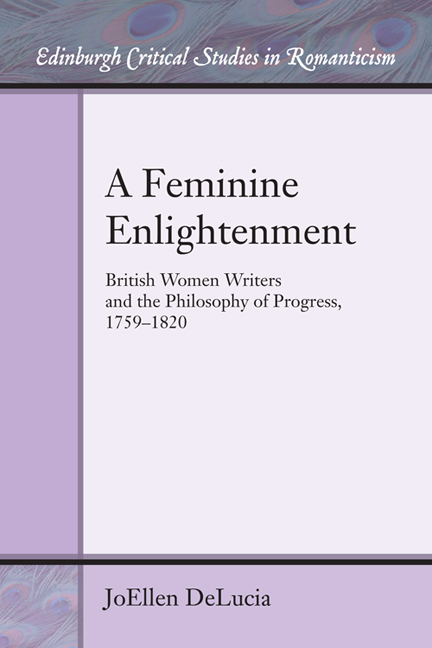Book contents
- Frontmatter
- Contents
- Acknowledgments
- Introduction: A Feminine Enlightenment?
- 1 The Progress of Feeling: The Ossian Poems and Adam Smith's Theory of Moral Sentiments
- 2 Ossianic History and Bluestocking Feminism
- 3 Queering Progress: Anna Seward and Llangollen Vale
- 4 Poetry, Paratext, and History in Radcliffe's Gothic
- 5 Stadial Fiction or the Progress of Taste
- Epilogue: Women Writers in the Age of Ossian
- Bibliography
- Index
4 - Poetry, Paratext, and History in Radcliffe's Gothic
Published online by Cambridge University Press: 05 August 2016
- Frontmatter
- Contents
- Acknowledgments
- Introduction: A Feminine Enlightenment?
- 1 The Progress of Feeling: The Ossian Poems and Adam Smith's Theory of Moral Sentiments
- 2 Ossianic History and Bluestocking Feminism
- 3 Queering Progress: Anna Seward and Llangollen Vale
- 4 Poetry, Paratext, and History in Radcliffe's Gothic
- 5 Stadial Fiction or the Progress of Taste
- Epilogue: Women Writers in the Age of Ossian
- Bibliography
- Index
Summary
While the author awaits hypothetical newspaper reviews, literary prizes, and other official recognitions, the epigraph is already, a bit, his consecration. With it, he chooses his peers and thus his place in the pantheon. (Gerard Genette, Paratexts 160)
It is tempting to skip or ignore the snippets of poetry Ann Radcliffe used to preface the chapters of her gothic fictions. Although the frequent poetical interludes in Radcliffe's novels take a back seat to most readers’ preference for plot, the fragments of poetry dispersed throughout her narratives, when considered together, are more than a distraction. E. J. Clery and Deidre Lynch posit that, once compiled together, her epigraphs compose a canon of vernacular literature. Radcliffe's catalogue includes perennial favorites Shakespeare and Milton, as well as largely forgotten eighteenth-century poets like William Mason and women writers like Charlotte Smith; however, many of the most frequently cited poems recreate elements of Celtic history and culture, such as James Thomson's The Castle of Indolence (1748), James Beattie's The Minstrel (1777), Thomas Gray's “The Bard” (1757), and James Macpherson's Ossian poems (1760–3). If paratext functions in a novel as what Gerard Genette calls a “boundary,” “border,” “threshold,” or in-between space, the Celtic poems Radcliffe favors negotiate the relationship between, on the one hand, her gothic tales of female imprisonment and terror and, on the other, the political and cultural imbalances created by a predominantly English British state. This chapter argues that Radcliffe's extensive paratextual apparatus in her most famous novel The Mysteries of Udolpho (1794) puts her heroine's quest in conversation with the questions of uneven development, imperial expansion, and the contested origins of British character raised by eighteenth-century philosophers and poets.
Genette has suggested that in selecting an epigraph, an author “chooses his peers and his place in the pantheon.” Radcliffe's extensive paratextual apparatus positions her not alongside the gothic and female authors with whom she is frequently classed but the poets she most often cites, such as Thomas Gray, William Collins, Macpherson, Beattie, and Thomson– who like Radcliffe found inspiration on the Celtic periphery. A serious consideration of what her biographer Rictor Norton calls the under-examined “‘poetic’ rather than ‘novelistic’ features of her oeuvre” challenges the marginal position in which Radcliffe has been placed by studies of the novel.
- Type
- Chapter
- Information
- A Feminine EnlightenmentBritish Women Writers and the Philosophy of Progress, 1759-1820, pp. 125 - 152Publisher: Edinburgh University PressPrint publication year: 2015



